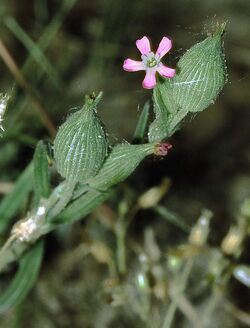Biology:Silene conica
From HandWiki
Revision as of 13:00, 22 July 2021 by imported>MainAI5 (linkage)
Short description: Species of flowering plant
| Silene conica | |
|---|---|

| |
| Scientific classification | |
| Kingdom: | Plantae |
| Clade: | Tracheophytes |
| Clade: | Angiosperms |
| Clade: | Eudicots |
| Order: | Caryophyllales |
| Family: | Caryophyllaceae |
| Genus: | Silene |
| Species: | S. conica
|
| Binomial name | |
| Silene conica | |
Silene conica is a species of flowering plant in the family Caryophyllaceae known by the common names striped corn catchfly[1] and sand catchfly.[2] It grows in dunes and sandy soils and is widespread in Europe and western Asia.[3] It has an annual life history and produces self-compatible hermaphroditic flowers and occasional male-sterile flowers (i.e., gynomonoecy). Like other members of Silene section Conoimorpha, S. conica is readily recognizable based on its bright pink petals and the prominent, parallel veins on its calyx.[4] In contrast to most flowering plants, S. conica appears to have a very rapid rate of mitochondrial mutation, and has the largest mitochondrial genome (11.3 Mb) ever identified.[5]
References
- ↑ "Silene conica". Natural Resources Conservation Service PLANTS Database. USDA. https://plants.usda.gov/core/profile?symbol=SICO3. Retrieved 14 November 2015.
- ↑ (xls) BSBI List 2007, Botanical Society of Britain and Ireland, https://bsbi.org/download/3542/, retrieved 2014-10-17
- ↑ Schischkin, B. K. 1970. Silene L. Pp. 442–528 in Flora of the USSR vol. 6, eds. V. L. Komarov and B. K. Schischkin. Jerusalem: Israel Program for Scientific Translation.
- ↑ Rautenberg A, Sloan DB, Aldén V, Oxelman B (2012) Phylogenetic relationships of Silene multinervia and Silene section Conoimorpha (Caryophyllaceae). Syst. Bot. 37: 226–237. doi: 10.1600/036364412x616792.
- ↑ Sloan DB, Alverson AJ, Chuckalovcak JP, Wu M, McCauley DE, et al. (2012) Rapid evolution of enormous, multichromosomal genomes in flowering plant mitochondria with exceptionally high mutation rates. PLoS Biol 10: e1001241. doi: 10.1371/journal.pbio.1001241.
Wikidata ☰ Q1737810 entry
 |

